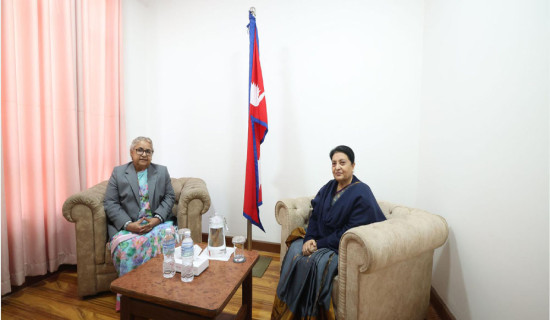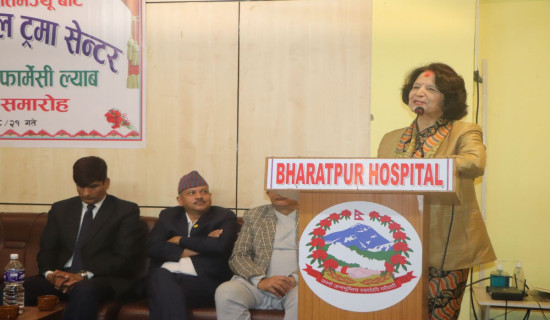- Sunday, 7 December 2025
Invest In Ergonomics For Workers’ Safety
When people discuss occupational health in Nepal, they refer to bodily injuries, safety risks, and exposure to chemicals. One of the most insidious threats to workers’ health is the dire state of ergonomics. Bank workers, librarians, and IT professionals are bent over screens. Garment and carpet workers sit on squat stools while weaving. Drivers spending twelve-hour shifts behind steering wheels are uneasily adjusted to fit their bodies. Construction workers carry heavy loads without the use of lifting instruments. No sector of Nepal’s labour force is untouched by ergonomic risk.
Ergonomics is the scientific field that focuses on designing workstations, tools, and tasks to fit the worker, rather than requiring the worker to adapt to them. The International Ergonomics Association (IEA) categorises ergonomics into three primary areas: physical, cognitive, and organisational. Physical ergonomics concentrates on anatomical, physiological, and biomechanical aspects related to physical activity, examining the impact of actions such as posture, repetitive movements, lifting, muscle response times, and muscle fatigue on the body. Cognitive ergonomics involves the brain's functions, including decision-making, reasoning, and perception.
Organisational ergonomics considers work structure, teamwork, telework, and quality management. It plays a vital role in reducing burnout, increasing job satisfaction, and boosting efficiency. Poor workplace ergonomics is most often manifested as an increase in Musculoskeletal Disorders (MSDs). They include back pain, neck pain, and conditions such as carpal tunnel syndrome, tennis elbow, shoulder pain, and joint pain. MSDs are now the world's leading cause of disability according to the World Health Organisation (WHO), and South Asia has a comparatively heavy burden of MSK disability, associated with a labour-intensive informal economy, as in Nepal.
Due to limited occupational health surveillance in Nepal, most disorders go undocumented. Workers might self-medicate or temporarily ease their symptoms at local pharmacies, but the root issues in the workplace remain unresolved. The key point for intervention is not just to treat symptoms but also to change the work environment to prevent future problems. For Nepali employers, the cost of neglecting ergonomics reaches beyond health problems. Unsuitable ergonomic conditions lead to higher absenteeism, lower productivity, increased staff turnover, and higher medical expenses due to injuries.
Its effects: labour inefficiency retarding economic development. These losses are silently absorbed in Nepal, where informal labour is widespread and labour protections are weak. Workstation adjustments don't have to be costly either. Affordable, locally available tools can yield significant benefits. In Nepal, ergonomic issues in specific sectors are leading to ample occupational health issues. Workers in the garment and textile industry often face prolonged periods of sitting, repetitive machine work, eye strain, and inadequate seat adjustments. Construction and brick kiln labourers carry heavy loads, bend forward, and endure exposure to noise, dust, and the sun.
Agricultural workers frequently perform tasks that require bending, squatting, and exposure to pesticides. The transportation and delivery fields are characterised by whole-body vibration, inadequate back support, and fatigue. Injuries among healthcare workers are often caused by patient handling, prolonged standing, mental stress, and exposure to chemical and radiation hazards. Workers in the crusher industries face dust pollution. Office, IT, and banking staff often face prolonged periods of sitting, which can lead to back pain, wrist pain, poor posture, and inadequate lighting.
Teachers experience long hours of standing, repetitive writing, chalk powder pollution, and non-ergonomic furniture. In every industry, these risks lower productivity, raise absenteeism, and drive up healthcare costs for the organisations. Ergonomic assessments and interventions can reduce injuries, distress, and increase work performance, providing economic and health benefits for Nepali workers. Nepal’s Labour Act provides general guidelines for a safe working environment. However, it lacks specifics regarding ergonomic guidelines and enforcement. The 2017 Occupational Safety and Health guidelines have set a milestone example by protecting workers through strong ergonomic principles.
Through safe workstation design, correct posture, and a healthy environment, they are creating a future of being free from MSDs and persistent injuries. Explicit instruction on lifting, repetitive tasks, and the use of safety tools makes it safer. They demonstrate a forward-thinking commitment to the well-being of workers and serve as a model that all workplaces should follow to protect their teams and enhance efficiency. Nepal’s shift toward digital work and tech-enabled service sectors has introduced a new ergonomic challenge: sedentary behaviour and screen fatigue. Office workers face unique risks, including back pain, neck strain, digital eye strain, and carpal tunnel syndrome. Occupational health and safety need to include the modern workforce.
Discomfort
Nepali workers have long endured discomfort in their jobs. However, this discomfort can be avoided if policymakers and unions address public health issues. Training workers about the value of ergonomics, recognising symptoms, and encouraging early reporting can improve the work culture. The presence of occupational physicians can be instrumental in awareness campaigns, teaching ergonomics, and recognition of injury patterns among workers. In the absence of such specialists at present, Nepal’s public health community needs to initiate training future ergonomic experts as a care practice.
Ergonomics is not a luxury in developing economies like Nepal. It is a cost-effective, evidence-based approach to protect workers, reduce economic losses, and strengthen business resilience. As Nepal modernises its workforce and transitions to a more formal economy, it must adopt ergonomic principles. Through occupational medicine, it is possible to incorporate ergonomic principles fairly for everyone: the worker’s health is linked with the company, society, and the nation. Nepal’s future depends on more than just creating jobs; it’s about establishing safe, sustainable, and humane environments.
Dr. Dahal works at Gurkha Welfare Trust Nepal (GWTN) as an Area Welfare Doctor for Bagmati.)

















